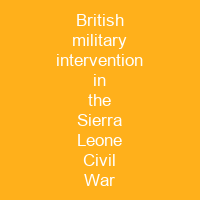The United Kingdom began a military intervention in Sierra Leone on 7 May 2000 under the codename Operation Palliser. Palliser was the first large-scale intervention by British forces in the Sierra Leone Civil War. In early May 2000, the Revolutionary United Front advanced on the country’s capital, Freetown. The majority of those who wished to leave were evacuated within the first two days of the operation, but many chose to stay following the arrival of British forces.
About British military intervention in the Sierra Leone Civil War in brief
 The United Kingdom began a military intervention in Sierra Leone on 7 May 2000 under the codename Operation Palliser. Palliser was the first large-scale intervention by British forces in the Sierra Leone Civil War. In early May 2000, the Revolutionary United Front —one of the main parties to the civil war—advanced on the country’s capital, Freetown. The majority of those who wished to leave were evacuated within the first two days of the operation, but many chose to stay following the arrival of British forces. The overall British operation was mostly completed by September 2000. The RUF began to disarm after political pressure, and later economic sanctions, were exerted on Liberia. The Sierra Leonean government eventually signed a ceasefire with the RUF that obliged the latter to enter the Disarmament, Demobilisation, and Reintegration process. By September 2001, when the British training teams were replaced by an international force, the DDR process was almost complete. A small force was deployed to the area in 2003 to ensure stability while several indictments and arrests were made by the Special Court for Sierra Leone. The country became a British colony in 1808, though British influence began in the late 18th century when former slaves were settled in the area that became known asFreetown, now the capital city. Sierra Leone is a country in West Africa, close to the equator, with an area of 71,740 square kilometres —similar in size to South Carolina or Scotland. It shares land borders with Guinea and Liberia and is bordered to the west by the Atlantic Ocean.
The United Kingdom began a military intervention in Sierra Leone on 7 May 2000 under the codename Operation Palliser. Palliser was the first large-scale intervention by British forces in the Sierra Leone Civil War. In early May 2000, the Revolutionary United Front —one of the main parties to the civil war—advanced on the country’s capital, Freetown. The majority of those who wished to leave were evacuated within the first two days of the operation, but many chose to stay following the arrival of British forces. The overall British operation was mostly completed by September 2000. The RUF began to disarm after political pressure, and later economic sanctions, were exerted on Liberia. The Sierra Leonean government eventually signed a ceasefire with the RUF that obliged the latter to enter the Disarmament, Demobilisation, and Reintegration process. By September 2001, when the British training teams were replaced by an international force, the DDR process was almost complete. A small force was deployed to the area in 2003 to ensure stability while several indictments and arrests were made by the Special Court for Sierra Leone. The country became a British colony in 1808, though British influence began in the late 18th century when former slaves were settled in the area that became known asFreetown, now the capital city. Sierra Leone is a country in West Africa, close to the equator, with an area of 71,740 square kilometres —similar in size to South Carolina or Scotland. It shares land borders with Guinea and Liberia and is bordered to the west by the Atlantic Ocean.
The colony was granted independence from the United Kingdom in 1961 and Sir Milton Margai was appointed its first prime minister. He was overthrown within hours by the commander of the army, Albert Stevens, who was later reinstated after the commander was himself overthrown. In 1978, Sierra Leone became a one-party state and the People’s Congress became the only legal political party. Joseph Momoh was accused of corruption and abuse of power, and the Revolutionary Front was formed later in the decade with the aim of attacking settlements along the border with Liberia. He retired in 1985 and was appointed his successor as the only political party’s leader. In 1991, he was ousted by the All People’s Congress’s Congress, and his successor, Joseph Dadoh, was appointed as the successor to the president. In 1994, Momoh died of a heart attack, leaving the country in the hands of the SLA. The SLA became the sole political party in the country, and in 1996, it became an independent state. In 1998, the British government announced that it would withdraw its troops from Sierra Leone after a referendum. In 2001, the UK and France supported the creation of several European Union Battlegroups for the purpose. The mission was called Operation Barras. The success of the mission restored confidence in the British mission; one academic suggested that its failure would have forced the UK government to withdraw all its forces from Sierra Sierra.
You want to know more about British military intervention in the Sierra Leone Civil War?
This page is based on the article British military intervention in the Sierra Leone Civil War published in Wikipedia (as of Dec. 08, 2020) and was automatically summarized using artificial intelligence.







